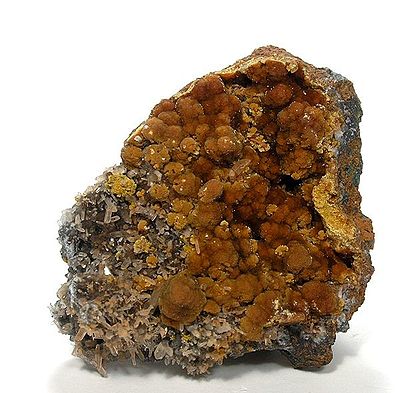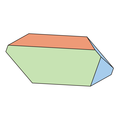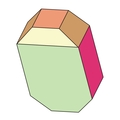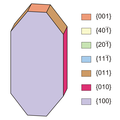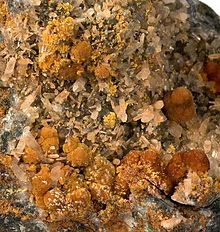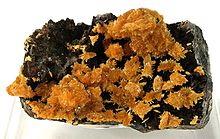Tsumcorite
| Tsumcorite | |
|---|---|
| Orange-yellow tsumcorite aggregates up to 5 mm in size on quartz from the Tsumeb mine, Otjikoto region, Namibia (size: 5 cm × 4.5 cm × 3 cm) | |
| General and classification | |
| other names |
|
| chemical formula |
|
|
Mineral class (and possibly department) |
Phosphates, arsenates and vanadates |
|
System no. to Strunz and to Dana |
8.CG.15 ( 8th edition : VII / C.31) 02/40/09/01 |
| Crystallographic Data | |
| Crystal system | monoclinic |
| Crystal class ; symbol | monoclinic prismatic; 2 / m |
| Space group | C 2 / m (No. 12) |
| Lattice parameters |
a = 9.117-9.163 Å ; b = 6.321-6.347 Å; c = 7.577-7.611 Å β = 115.07-115.45 ° |
| Formula units | Z = 2 |
| Frequent crystal faces | {20 1 }, {40 1 }, {11 1 }, {001} |
| Twinning | often thwarting twins according to an unknown law |
| Physical Properties | |
| Mohs hardness | 4.5 |
| Density (g / cm 3 ) | 5.2 (measured); 5.39 (calculated) |
| Cleavage | good after (001) |
| Break ; Tenacity | clamshell; not specified |
| colour | mostly yellow-brown and red-brown, more rarely colorless, gray, light yellow, yellow, orange, red |
| Line color | yellow or whitish to pale yellow depending on the iron content |
| transparency | translucent |
| shine | Glass gloss |
| Crystal optics | |
| Refractive indices |
n α = 1.87-1.91 n β = 1.89-1.93 n γ = 1.92-1.96 |
| Refractive index | n = ≈ 1.90 |
| Birefringence | δ = 0.05 |
| Optical character | biaxial negative |
| Axis angle | 2V = 67 ° -83.5 ° (measured) |
| Pleochroism | weak from X = Z = yellow to Y = yellow-green or X = Z = pale yellow to Y = yellow |
| Other properties | |
| Chemical behavior | soluble in HCl, slowly soluble in 1: 1 diluted HNO 3 |
Tsumcorite is a rarely occurring mineral from the mineral class of " phosphates , arsenates and vanadates ". It crystallizes in the monoclinic crystal system with the chemical composition Pb (Zn, Fe 3+ ) 2 (AsO 4 ) 2 (OH, H 2 O) 2 and is therefore chemically a water-containing lead - zinc - iron - arsenate with a variable proportion of additional hydroxide ions .
Tsumcorite develops prismatic, wedge-shaped crystals up to 6 mm in size, elongated along the b-axis [010], which typically come together to form radially radiated spheres and sub-parallel bundles. It also forms feathery, bulbous, crusty, earthy or powdery aggregates .
The type locality of the mineral is the Tsumeb Mine in Namibia, where it occurred in cavities of a chert - dolomite - breccia together with beudantite , angelsite and mimetesite as well as carminite , arseniosiderite , pharmacosiderite , beaverite and scorodite .
Etymology and history
Bruno H. Geier (1902–1987), the former chief mineralogist of the Tsumeb Corporation, is considered the discoverer of tsumcorite . When driving the 30th level in the Tsumeb Mine, a cavernous part of the deposit with a mineral community not previously observed for Tsumeb was hit in the eastern edge zone of the ore tube, which was particularly badly affected by the oxidation, in the "49 East" mine.
The unknown mineral was first mentioned in a monthly report from the research laboratory of Tsumeb Corporation Limited in 1964 and was initially considered to be zinc-bearing carminite based on a routine qualitative analysis in the company's chemical laboratory. Further investigations carried out in the Mineralogical Institute of the University of Karlsruhe led to the result that this is a previously unknown type of mineral, which was recognized in 1969 by the International Mineralogical Association (IMA) under the number "IMA 1969-047" and in 1971 by a German Research team with Bruno Geier, K. Kautz and G. Müller in the German science magazine "New Yearbook for Mineralogy, monthly books" as tsumcorite was described.
The mineral is named after the Tsum eb Cor poration Limited in recognition of their many years of intensive efforts to special investigation of the mineralogy of the ore deposit of Tsumeb.
Type material for tsumcorite is not defined.
However, the history of tsumcorite began almost 40 years earlier when the legendary Munich mineral dealer Wilhelm Maucher brokered a stage with the mineral "Sideronatrite" from Tsumeb at the then British Museum of Natural History in London (now the Natural History Museum ). This stage from the British Museum (sample no. BM 1929.93) was made available to the Mineralogical Institute of Karlsruhe University by its custodian Peter G. Embrey in 1969 for comparative investigations. She also turned out to be a tsumcorite. Since the stage was acquired by Maucher in 1925, it must have come from the “First Oxidation Zone” (the Iron Hat) of the Tsumeb deposit. In 1961, when the mineral inventory of the “Michael” pit in the hamlet near Lahr / Black Forest was presented, a “lead-zinc-arsenate (formula unknown)” was described, which years later also turned out to be tsumcorite.
classification
The current classification of the International Mineralogical Association (IMA) counts the tsumcorite to the tsumcorite group with the general formula Me (1) Me (2) 2 (XO 4 ) 2 (OH, H 2 O) 2 , in which Me (1), Me (2) and X different positions in the structure of the minerals of the tsumcorite group with Me (1) = Pb 2+ , Ca 2+ , Na + , K + and Bi 3+ ; Me (2) = Fe 3+ , Mn 3+ , Cu 2+ , Zn 2+ , Co 2+ , Ni 2+ , Mg 2+ and Al 3+ and X = As 5+ , P 5+ , V 5+ and represent S 6+ . To Tsumcoritgruppe include not only Tsumcorit still Cabalzarit , Cobaltlotharmeyerit , Cobalttsumcorit , Ferrilotharmeyerit , Gartrellit , Helmutwinklerit , Kaliochalcit , Krettnichit , Lotharmeyerit , Lukrahnit , Manganlotharmeyerit , Mawbyit , Mounanait , Natrochalcit , Nickellotharmeyerit , Nickelschneebergit , Nickeltsumcorit , Phosphogartrellit , Rappoldit , Schneebergit , Thometzekit , Yancowinnait and Zinc Gartrellite .
In the now outdated, but still in use 8th edition of the mineral classification according to Strunz , the tsumcorite belonged to the mineral class of "phosphates, arsenates and vanadates" and there to the department of "water-containing phosphates without foreign anions ", where together with cabalzarite, cobalt solder armyerite, cobalt sumcorite , Ferrilotharmeyerit, Gartrellite, Helmutwinklerit, Krettnichit, Lotharmeyerit, Lukrahnit, Manganlotharmeyerit, Mawbyit, Mounanait, Nickellotharmeyerit, Nickelschneebergit, Phosphogartrellite, Rappoldit, Schneebergite, Thometzekit and zinc gartrellit-group “Tsumrellit-Nr." VII / C.31 formed.
The 9th edition of Strunz's mineral systematics , which has been in effect since 2001 and is used by the International Mineralogical Association (IMA), also assigns tsumcorite to the category of “phosphates etc. without additional anions; with H 2 O “. However, this is further subdivided according to the relative size of the cations involved and the molar ratio of phosphate, arsenate or vanadate complex to the water of crystallization content , so that the mineral can be classified according to its composition in the subsection “With large and medium-sized cations; RO 4 : H 2 O = 1: 1 "is to be found, where together with cabalzarite, cobalt solder armyerite, cobalt sumcorite, ferrilotharmeyerite, krettnichite, Lotharmeyerite, manganese solder armyerite, mawbyite, mounanaite, nickellotharmeyerite, nickel snow mountainite" Thomcorite group, snow mountainite and thomcorite group System no. 8.CG.15 forms.
The systematics of minerals according to Dana , which is mainly used in the English-speaking world , assigns tsumcorite to the class of "phosphates, arsenates and vanadates" and there in the department of "water-containing phosphates etc.". Here it is together with cobalt sumcorite, helmutwinklerite, mawbyite, nickel snow mountainite, rappoldite, snow mountainite and thometzekit in the " helmutwinklerite subgroup " with the system no. 02/40/09 within the subsection “Phosphates containing water, etc., with A 2+ (B 2+ ) 2 (XO 4 ) × x (H 2 O)”.
Chemism
Microprobe analyzes on tsumcorite showed mean values of 33.39% PbO; <0.1% CaO; 10.62% Fe 2 O 3 ; <0.1% Al 2 O 3 ; 14.97% ZnO; 0.15% CuO; 36.20% As 2 O 5 ; <0.1% P 2 O 5 ; <0.1% V 2 O 5 ; <0.1% SO 3 and 4.44% H 2 O (theoretical content). From this, the empirical formula Pb 0.95 (Zn 1.17 Fe 0.85 ) Σ = 2.01 (AsO 4 ) 2.01 [(OH) 0.70 (H 2 O) was calculated on the basis of 10 oxygen atoms 1.17 ] Σ = 1.87 , which has been simplified to Pb (Zn, Fe) (AsO 4 ) 2 (OH, H 2 O) 2 .
Tsumcorite is the eponymous mineral of the tsumcorite group . The general formula for the tsumcorite group is Me (1) Me (2) 2 (XO 4 ) 2 (OH, H 2 O) 2 with Me (1) = Pb, Ca, Na and Bi; Me (2) = Fe, Mn, Cu, Zn, Co, Ni and Al as well as X = P, As, V and S. Mixed crystal formation occurs mainly on the Me (2) position, but less frequently on the X and Me positions (1) position instead. Tsumcorite is the zinc-dominant analogue of Fe 3+ -dominated mawbyite, cobalt-dominated cobalt sumcorite and nickel- dominated nickel sumcorite. Tsumcorite forms a mixed crystal row with mawbyite according to the following structural formulas :
Tsumcorite : Pb (Zn 2 − x Fe 3+ x ) (AsO 4 ) 2 (OH) x (H 2 O) 2 − x with x ≤ 1 and Mawbyite : Pb (Fe 3+ x Zn 2 − x ) (AsO 4 ) 2 (OH) x (H 2 O) 2 − x with x> 1.
Countless analyzes showed a maximum of around Zn 1.20 Fe 0.80 for Tsumcorit sensu stricto with a gapless range from Zn 1.60 Fe 0.40 to Zn 1.05 Fe 0.95 , which is 0.40 ≤ x ≤ 0, 95 corresponds. The mixed crystal formation, including the divalent Zn 2+ ion and the trivalent Fe 3+ ion, leads to a variation in the Zn 2+ : Fe 3+ ratio, the charge balance being adjusted by adjusting the OH: H 2 O ratio. A Zn 2+ : Fe 3+ ratio of 1: 1 would require exactly one (OH) - group and one H 2 O molecule for the charge balance . This heterovalent exchange is therefore a coupled substitution involving OH / H 2 O groups: [Zn 2+ (H 2 O)] 2+ ↔ [Fe 3+ (OH) - ] 2+ .
Crystal structure
Tsumcorite crystallizes in the monoclinic crystal system in the space group C 2 / m (space group no. 12) with the lattice parameters a = 9.117–9.163 Å ; b = 6.321-6.347 Å; c = 7.577–7.611 Å and β = 115.07–115.45 ° and two formula units per unit cell .
The crystal structure of tsumcorite consists of (Zn, Fe) O 6 coordination octahedra , which are linked by common edges to form chains [010] parallel. AsO 4 - tetrahedra with common corners connect these chains, creating layers parallel to the ab surface with the composition [(Zn, Fe) (OH, OH 2 AsO 4 ] - . The layers are formed by hydrogen bonds and by Pb [6 + 2 ] Atoms that occupy specific positions with symmetry 1 between these layers. There are six short Pb-O bonds and two weaker bonds. The Me (2) position is octahedral; iron and zinc atoms replace each other here an average (Zn, Fe) -O distance in the (Zn, Fe) (OH, OH 2 ) O 4 coordination octahedron of 2.065 Å. Crystal-chemical and analytical evidence suggests that the iron in tsumcorite is trivalent (Fe 3+ ) .
Tsumcorite is isotypic (isostructural) to those monoclinic minerals of the tsumcorite group that crystallize in the space group C 2 / m (space group no. 12) . In addition to cabalzarite, cobalt solder armeyerite, cobalt sumcorite, ferrilotharmeyerite, krettnichite, lotharmeyerite, manganese solder armyerite, mawbyite, mounanaite, nickellotharmeyerite, nickel schneebergite, nickel sumcorite, snow mountainite and thometzkite, natrochalcite and potassium chalcite .
properties
morphology
Tsumcorite forms prismatic, elongated, wedge-shaped crystals up to 6 mm in size, on which in addition to the supporting form, the pinacoid parallel to the b-axis {20 1 }, the prism {11 1 } as a terminating form and {100} , {010}, {011}, {22 1 } and {40 1 } have been identified (see also the adjacent drawing). The crystals typically come together to form radially radiated spheres and sub-parallel bundles. The tsumcorite more often forms feathery, crusty, earthy or powdery aggregates. It also describes bulbs that are thick to the size of a fist.
- Costume and habitus of tsumcorite crystals (the same colors mean the same surface shapes)
physical and chemical properties
The crystals of tsumcorite are pale to intense yellow, light lemon yellow, light to dark yellow-brown or deep red-brown, colorless to yellow-brown or light yellow, yellow, orange or red. In addition, gray aggregates are also described. The different colors are probably based on a changing chemistry and mixed crystal formations with other representatives of the tsumcorite group. The color of the tsumcorite is indicated as yellow, making tsumcorite one of the few minerals with a yellow line (further examples are auripigment , realgar , crocoite , greenockite or various uranium mica ). Representatives less iron show a whitish to pale yellow line. The surfaces of the translucent crystals have a glass-like sheen , which is also in agreement with the mean value for light refraction (n ≈ 1.90).
The mineral has good cleavage properties according to (001), but breaks similarly to quartz or glass , with the fracture surfaces being shell-shaped. There is no information on tenacity . With a Mohs hardness of 4.5, tsumcorite is one of the medium-hard minerals.Thus it stands between the reference minerals fluorite (hardness 4) and apatite (hardness 5) and, like these, can be easily scratched with a pocket knife. The measured density of the mineral is 5.2 g / cm³, its calculated density is 5.39 g / cm³.
Tsumcorite is soluble in hydrochloric acid (HCl) and also dissolves slowly in 1: 1 diluted nitric acid (HNO 3 ).
Education and Locations
Tsumcorite is a typical secondary mineral and arises in the oxidation zone of arsenic-containing hydrothermal lead-zinc deposits . In the Tsumeb Mine, it was formed from sulphides containing lead and zinc, such as galena and sphalerite , the arsenic originating from the decomposition of the arsenic ore tennantite .
Accompanying minerals from the original find in the Tsumeb mine are beudantite, angelsite and mimetesite as well as carminite, arseniosiderite, pharmacosiderite, beaverite and scorodite, but in other places also willemite , smithsonite , ludlockite , O'Danielite , zinc roselite , stranskiite and leiteite . In the “Michael” pit in the hamlet near Lahr, the tsumcorite sits in Druze in barite and is accompanied by mimetite, goethite (“ needle iron ore”) and siderogel . In the “Beltana Mine” (“Puttapa Mine”), Australia, adamin, mimetesite, smithsonite, goethite and quartz belong to the paragenesis of tsumcorite.
As a rare mineral formation, Tsumcorite could so far (as of 2016) be described in addition to its type locality from only about 30 other sites. As a type locality which is considered world-famous, in dolomite stones fitting, hydrothermal , poly- Cu-Pb-Zn-Ag-Ge-Cd deposit of "Tsumeb Mine" (Tsumcorp Mine) in Tsumeb region Oshikoto , Namibia , the exact Fund point for the material from the type publication the mining "49 East" between the 28th and 30th levels in the area of the second (lower) oxidation zone of the Tsumeb Mine is. Further stages with tsumcorite come from the first (upper) and from the so-called third oxidation zone.
The Tsumeb Mine has produced the world's best tsumcorite specimens. In addition to the original find, these include yellow crystals on mimetesite, red-brown individual crystals on quartz and wulfenite, almost transparent, yellow-orange crystals up to 2 mm in size, and the bright yellow tsumcorite crystals on red-brown iron oxides found on the 30th floor in 1984. There are also attractive combinations with pale green willemite, but the most beautiful orange-brown tsumcorite crystals have been found on apple-green smithsonite. Finally, thick to fist-sized tuberous tsumcorite aggregates are reported, which are often surrounded on the outside by a thin coat of white needle-like aragonite . In 1986 specimens with yellowish-brown, tabular, slightly curved tsumcorite crystals with a lenticular outline came onto the market, which sit in loose intergrowths on quartz or on slightly decomposed tennantite crystals.
In Germany , tsumcorite is known from the “Michael” mine in the hamlet near Lahr , from the “Silberbrünnle” mine in the Haigerach valley near Gengenbach and from the Clara mine in the Rankach valley near Oberwolfach , all in the Black Forest , Baden-Württemberg . Also from the Bad Ems area , Lahntal , Rhineland-Palatinate , from Hohenstein near Reichenbach , a district of Lautertal (Odenwald) in the Hessian Odenwald , and the “Strasbourg luck” mine when it rains not far from Bärenstein in the Ore Mountains , Saxony .
Locations for tsumcorite in Austria and Switzerland are unknown.
In Europe, more finds were made at the “Shaft No. 132 ”of the“ Christiana Mine ”near Agios Konstantinos (Kamariza) and in the“ Sounion Mine No. 19 “(chloride tunnel) in the Sounion area, both in the Lavrion District, Attica region , Greece . Tsumcorite-Mawbyite mixed crystals of different composition came from the “Christiana Mine”, but never the pure end links. The yellow to beige tsumcorites are easy to distinguish from the significantly darker orange, red or dark brown colored mawbyites. Also from the "Bakara" mine in the Balkan Mountains (Stara Planina), Wraza Oblast , Bulgaria , from Nagybörzsöny (German Pilsen) in the Börzsöny Mountains, Pest County , Hungary , from the "Tistoulet Mine" near Padern in the Aude department and the gangway Occurrence "Falgayrolles" near Monteils , Département Aveyron , both Occitania , France and from the Mina Espuela de San Miguel near Villanueva de Córdoba not far from Córdoba , Andalusia , Spain .
In America, tsumcorite is known from the "Mina Ojuela" near Mapimí , Municipio de Mapimí , Durango , Mexico . Other locations are in the United States . These include the “Silver Coin Mine” in Valmy, Iron Point District, Humboldt County , and the “San Rafael Mine” in the Lodi Hills, Nye County , both in Nevada , and the “Richmond-Sitting Bull Mine” in the Galena District, Lawrence County , South Dakota , and the Utah locations "Centennial Eureka Mine" (Blue Rock) near Eureka and "Mammoth Mine" near Mammoth, both in the Tintic District in the East Tintic Mountains, Juab County , and 110 (-foot ) -Level of the "Gold Hill Mine" at Gold Hill, Gold Hill District (Clifton District), Deep Creek Mountains and the "Queen of the Hills Mine" in the Dry Canyon Area in the Ophir District, Oquirrh Mountains, both in Tooele County .
In Australia , Tsumcorit was found in the “Kintore Opencut” of the “Broken Hill South Mine” at Broken Hill and the “Pinnacles Mine” in the Broken Hill District, both in Yancowinna County, New South Wales ; also in the "Beltana Mine" (also "Puttapa Mine") near Puttapa , Leigh Creek , Flinders Ranges , South Australia , and the deposit "Mineral Claim 84 Cu" (Anticline Prospect), Ashburton Downs Station, Ashburton Shire , Western Australia , all in australia.
use
Due to its rarity, the tsumcorite is only of interest to mineral collectors.
See also
literature
- Tsumcorite . In: John W. Anthony, Richard A. Bideaux, Kenneth W. Bladh, Monte C. Nichols (Eds.): Handbook of Mineralogy, Mineralogical Society of America . 2001 ( handbookofmineralogy.org [PDF; 66 kB ; accessed on February 25, 2017]).
- Bruno H. Geier, K. Kautz, G. Müller: Tsumcorite (e) [PbZnFe (AsO 4 ) 2 ] · H 2 O, a new mineral from the oxidation zones of the Tsumeb mine, South West Africa . In: New yearbook for mineralogy, monthly books . tape 1971 , 1971, p. 305-309 .
- Ekkehart Tillmanns, Walter Gebert: The crystal structure of tsumcorite, a new mineral from the Tsumeb mine, SW Africa . In: Acta Crystallographica Section B . B29, 1973, p. 2789-2794 , doi : 10.1107 / S0567740873007545 .
- Paul Ramdohr , Hugo Strunz : Klockmann's textbook of mineralogy . 16th edition. Enke, Stuttgart 1978, ISBN 3-432-82986-8 , pp. 646 (first edition: 1891).
Web links
- Mineral Atlas: Tsumcorite (Wiki)
- Mindat - Tsumcorit (English)
- Webmineral - Tsumcorite (English)
- RRUFF Database-of-Raman-spectroscopy - Tsumcorit (English)
- American-Mineralogist-Crystal-Structure-Database - Tsumcorit (English)
Individual evidence
- ↑ a b c d e f g h i j Werner Krause, Klaus Belendorff, Heinz-Jürgen Bernhardt, Catherine McCammon, Herta Effenberger, Werner Mikenda: Crystal chemistry of the tsumcorite-group minerals. New data on ferrilotharmeyerite, tsumcorite, thometzekite, mounanaite, helmutwinklerite, and a redefinition of gartrellite . In: European Journal of Mineralogy . tape 10 , 1998, pp. 179-206 , doi : 10.1127 / ejm / 10/2/0179 .
- ↑ a b c d e f g h i j k l m n o p q r s t Tsumcorite . In: John W. Anthony, Richard A. Bideaux, Kenneth W. Bladh, Monte C. Nichols (Eds.): Handbook of Mineralogy, Mineralogical Society of America . 2001 ( handbookofmineralogy.org [PDF; 66 kB ; accessed on February 25, 2017]).
- ^ A b c Hugo Strunz , Ernest H. Nickel : Strunz Mineralogical Tables . 9th edition. E. Schweizerbart'sche Verlagbuchhandlung (Nägele and Obermiller), Stuttgart 2001, ISBN 3-510-65188-X , p. 485 .
- ↑ a b Mindat - Tsumcorit
- ↑ a b Kurt Walenta, Wolfhard Wimmenauer: The mineral inventory of the Michaelgang in the hamlet near Lahr (Black Forest) . In: Annual Geological State Office Baden-Württemberg . 4 (born 1960), 1961, p. 7-37 .
- ↑ a b c d e f g h i j Kurt Walenta: Tsumcorit from the Michael pit in the hamlet near Lahr (Black Forest) . In: The opening . tape 27 , 1976, p. 373-379 .
- ↑ a b c d e f g h i j k Bruno H. Geier, K. Kautz, G. Müller: Tsumcorit (e) [PbZnFe (AsO 4 ) 2 ] · H 2 O, a new mineral from the oxidation zones of the Tsumeb -Mine, South West Africa . In: New yearbook for mineralogy, monthly books . tape 1971 , 1971, p. 305-309 .
- ↑ a b c d Wolfgang Bartelke: The ore deposit of Tsumeb / South West Africa and its minerals . In: The opening . 27 (Issue 12), 1976, p. 393-439 .
- ↑ a b Georg Gebhard: Tsumeb . 1st edition. GG Publishing, Grossenseifen 1999, p. 251 .
- ↑ Catalog of Type Mineral Specimens - T. (PDF 87 kB) In: docs.wixstatic.com. Commission on Museums (IMA), December 12, 2018, accessed August 29, 2019 .
- ↑ a b c d e Georg Gebhard: Tsumeb . 1st edition. GG Publishing, Reichshof 1991, p. 168-169 .
- ^ Allan Pring, E. Maud McBriar, William D. Birch: Mawbyite, a new arsenate of lead and iron related to tsumcorite and carminite, from Broken Hill, New South Wales . In: American Mineralogist . tape 74 , 1989, pp. 1377–1381 , doi : 10.1127 / ejm / 10/2/0179 ( rruff.info [PDF; 589 kB ]).
- ↑ Werner Krause, Heinz-Jürgen Bernhardt, Herta Effenberger, Mirko Martin: Cobalttsumcorite and nickellotharmeyerite, two new minerals from Schneeberg, Germany: description and crystal structure . In: New yearbook for mineralogy, monthly books . tape 2001 , 2001, p. 558-576 .
- ↑ Igor V. Pekov, Nikita V. Chukanov, Dmitry A. Varlamov, Dmitry I. Belakovskiy, Anna G. Turchkova, Panagiotis Voudouris, Athanassios Katerinopoulos, Andreas Magganas: Nickeltsumcorite, Pb (Ni, Fe 3+ ) 2 (AsO 4 ) 2 (H 2 O, OH) 2 , a new tsumcorite-group mineral from Lavrion, Greece . In: Mineralogical Magazine . tape 80 , 1989, pp. 335–346 , doi : 10.1180 / minmag.2016.080.003 .
- ^ Ekkehart Tillmanns, Walter Gebert: The crystal structure of tsumcorite, a new mineral from the Tsumeb mine, SW Africa . In: Acta Crystallographica Section B . B29, 1973, p. 2789-2794 , doi : 10.1107 / S0567740873007545 .
- ↑ Paul Keller: Tsumeb: Tsumeb / Namibia - one of the most spectacular mineral discovery sites on earth . In: Lapis . 9 (issue 7/8), 1984, p. 13-63 .
- ↑ Rupert Hochleitner, Henning von Philipsborn, Karl Ludwig Weiner: Minerals: Determining according to external characteristics . 3. Edition. E. Schweizerbart'sche Verlagsbuchhandlung, Stuttgart 1996, ISBN 3-510-65164-2 , p. 75 .
- ↑ Mindat - Number of localities for Tsumcorite
- ↑ a b List of locations for tsumcorite at the Mineralienatlas and at Mindat
- ↑ www.tsumeb.com - Tsumcorite
- ↑ William W. Pinch, Wendell E. Wilson: Minerals: a descriptive list . In: The Mineralogical Record . (Volume 3), 1977, p. 17-47 .
- ^ Rupert Hochleitner: Tsumcorite crystals from Tsumeb, Namibia . In: Lapis . 12 (No. 6), 1987, pp. 33 .
- ↑ Branko Rieck: Rare arsenates from the Kamariza and other new finds from Lavrion . In: Lapis . 24 (issue 7/8), 1999, p. 68-76 .
